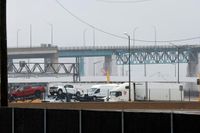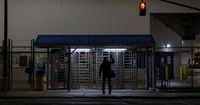In a significant turn of events, the Canadian government has begun collecting a 25 percent tariff on cars and trucks imported from the United States as of April 9, 2025. This measure is part of Canada's response to the ongoing trade tensions ignited by U.S. President Donald Trump's tariffs on Canadian exports. The estimated revenue from these levies is projected to reach around 8 billion Canadian dollars (approximately $5.7 billion) annually, which is intended to support companies and workers adversely affected by U.S. tariffs.
The automotive industry in Canada, a crucial sector, has already begun to feel the impact of these tariffs. Hours before the 25 percent U.S. tariff on Canadian-made autos took effect, Stellantis announced a two-week closure of its assembly plant in Windsor, Ontario, as it reevaluated its operational plans. Flavio Volpe, president of the Automotive Parts Manufacturers’ Association of Canada, estimated that this shutdown could idle up to 12,000 workers in both Canadian and U.S.-owned parts plants.
As the economic fallout from U.S. tariffs continues to unfold, Canadian Prime Minister Mark Carney has not yet detailed how the funds generated from the auto tariffs will be allocated. In addition to the $5.7 billion from the automotive tariffs, Canada anticipates generating an annual revenue of $42 billion from other tariffs imposed in March 2025 in response to earlier U.S. actions.
Amidst this economic crisis, the Canadian government is exploring various strategies to mitigate the adverse effects of job losses and plant closures. Ontario Premier Doug Ford announced on April 7, 2025, that businesses would be allowed to defer tax payments due at the end of June by several months, which is expected to provide businesses with an estimated 9 billion Canadian dollars in liquidity. Furthermore, the province plans to return 2 billion Canadian dollars from a surplus in a workplace accident insurance fund to employers as part of its support measures.
The Western province of Manitoba has also introduced tax payment deferrals, while Quebec and New Brunswick are offering low-cost loans to businesses adjusting to the new economic landscape. The Business Development Bank of Canada has established a special loan program for companies impacted by the tariffs. In another move reminiscent of pandemic-era policies, unemployment insurance rules have been modified to assist workers whose hours have been reduced due to the tariff-induced economic strain.
In a recent statement, Rob Gillezeau, an economics professor at the University of Toronto, expressed concerns about the long-term implications of these tariffs. He noted, "Usually you expect a return to normal, but this is potentially a permanent structural trade shock." He highlighted the uncertainty surrounding which firms will survive in this challenging environment.
On the political front, the Canadian federal election has been significantly influenced by the U.S. tariffs, with party leaders unveiling their immigration policies in response to the economic challenges. Myer Siemiatycki, a professor emeritus at Toronto Metropolitan University, suggested that increasing Canada's population through immigration could bolster the domestic market and reduce reliance on the U.S. economy. He remarked, "Maybe immigration is the answer, not the problem," emphasizing the potential benefits of a larger domestic market.
However, the Liberal Party leader, Mark Carney, has indicated a more cautious approach, stating on April 7, 2025, that he would manage immigration levels at lower rates until Canada can adequately accommodate more immigrants. Carney acknowledged, "We have not lived up to our promise to those we brought to this country." In contrast, Conservative Party leader Pierre Poilievre has proposed even stricter immigration cuts, linking immigration rates to housing availability. He stated, "We can’t increase our population by a million people a year when we’re only adding 200,000 homes," underscoring the housing crisis facing many Canadians.
Despite the shifting political landscape, Siemiatycki cautioned against the negative rhetoric surrounding immigration, which has often been blamed for various socio-economic issues in Canada. He noted that the focus on immigration had become a tool for some political leaders to deflect attention from other pressing challenges, stating, "I don’t think it’s a bad thing that immigration has declined somewhat as a top priority of Canadians and political leaders."
As the situation continues to develop, Canada finds itself navigating a complex web of economic challenges and political pressures, all while seeking to redefine its relationship with the United States. The recent announcement that Canada would not be subject to a universal 10 percent tariff imposed by the U.S. on most countries has provided some relief, as confirmed by Kirsten Hillman, Canada's ambassador to the United States. However, Canada remains subject to a series of tariffs that are expected to drive up costs for consumers and impact businesses.
Carney welcomed the U.S. decision to pause steep tariffs on other countries, viewing it as a potential opportunity for Canada to renegotiate its trade agreements. He stated, "We must continue to deepen our relationships with other trading partners that share our values, including the free and open exchange of goods, services, and ideas." Meanwhile, the Canadian Chamber of Commerce has expressed concerns about the ongoing tariffs, arguing that they represent a tax that Americans will ultimately bear.
Looking ahead, both Carney and Poilievre have expressed a desire to initiate renegotiations of the United States-Mexico-Canada Agreement (USMCA) as it approaches its renewal in 2026. However, legal experts warn against Canada being among the first countries to negotiate with the U.S., suggesting that it could lead to unfavorable terms. As the stakes continue to rise, the Canadian government faces the challenge of balancing immediate economic needs with long-term strategic goals in a rapidly changing global trade environment.






